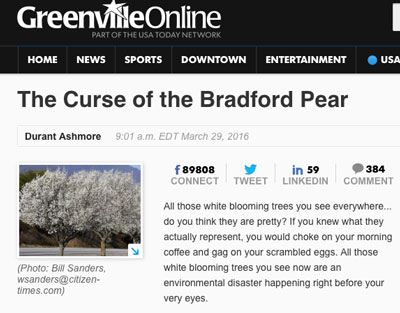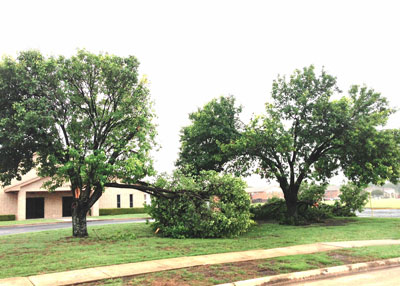Are Bradford Pears Good or Horrific?
Odds are that you, like I, planted Bradford pears in the past. If you don’t regret that decision now, you might after you read this man’s rather blunt blog on it earlier this week.
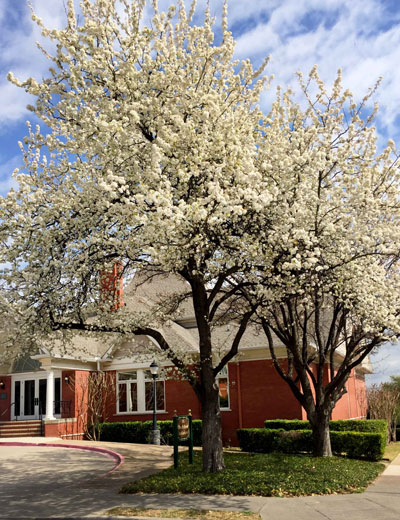
You probably saw trees like this all over Texas 6 or 7 weeks back. In spite of their beauty, however, Bradford pears have major drawbacks.
I posted my comments regarding Bradford and other ornamental pears on my Facebook page on Tuesday. As of “press time” for e-gardens, it’s been viewed by more than 60,000 FB readers. Since you may not be on Facebook or may have missed seeing it even if you are, here are my comments, followed by his original blog.
First however, three photos that tell part of the tale.
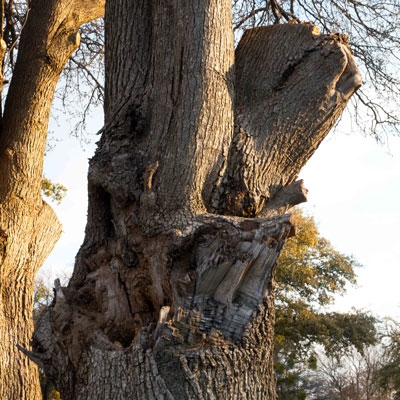
A closer look reveals why the branches have broken out – very narrow, weak angles.
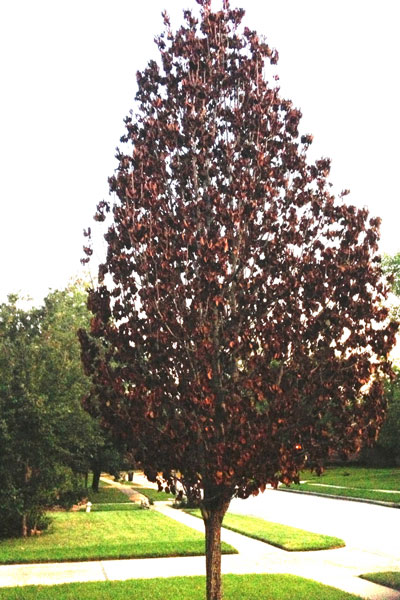
Cotton root rot takes its toll on a mature and formerly lovely pear.
From my Facebook page, Tuesday, March 29.
“Garden Tip: I am being covered up with inquiries about this man’s post re: Bradford pears. Please let me address it briefly and honestly from my perspective.
The facts, in my steps in processing them:
I do not know this man. He is probably a fine horticulturist, but I do take exception with some of his comments. (Re: white-flowering trees in general, for example.)
More than that, the way in which he expresses his feelings seems far too challenging, too in-your-face to the people who planted them. I planted them early in my career, and I began admitting the mistake 25 or 30 years ago.
I admit that his post might sound to me like my posts admonishing people not to “top” their crape myrtles might sound to others who don’t know me. That’s a passion for me. Fair enough. Whistle blown on myself.
The specter of “invasive” plants is an imprecise science at best. What is invasive in one area (Chinese tallow trees in Beaumont) isn’t terribly invasive in other areas (Chinese tallow trees in Odessa). It could be due to different temperatures, different rainfall or different soils.
In and around DFW where I have lived and gardened for 46 years, Bradford pears have not invaded rural areas. In fact, I don’t recall seeing SEEDLINGS of them in any garden with which I have been familiar. ROOT SPROUTS from the rootstocks of Callery pears – that’s a different story.
I checked with a highly respected horticulturist in East Texas late last night. He says there are stands of Callery pear from East Texas probably to the East Coast.
So, while the man’s post seems entirely appropriate for his part of the East Coast, some of his facts may be things I would contest. And his reasoning probably wouldn’t apply to much of Texas (western 80-85 percent).
All of which begs the question: should we plant Bradford pears at all anyway? And my answer to that is “No.” I had three, but by the mid-80s, less than 20 years after they were introduced to us by our government, I had taken mine out. Not because they were ever an invasive threat in my area, but because I didn’t want their branches falling on our house, our car or our family and friends (in the reverse order). They are also perhaps the most susceptible plant we have to the fatal cotton root rot fungus that inhabits alkaline soils.
That’s my “Texan” take on this man’s post. I support his conclusion, but for different reasons. And I might have said it a bit more gently. That’s just my read on it.”
And here was his original blog:
http://www.greenvilleonline.com/story/life/2016/03/21/curse-bradford-pear/82070210/
